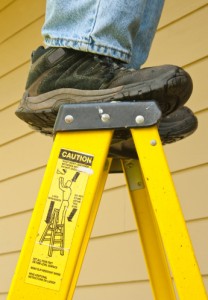 Falls from ladders on worksites are among the leading causes of employee injuries and deaths in the nation, according to a recent study published by the U.S. Centers for Disease Control and Prevention (CDC).
Falls from ladders on worksites are among the leading causes of employee injuries and deaths in the nation, according to a recent study published by the U.S. Centers for Disease Control and Prevention (CDC).
Researchers found that over the last 10 years 43 percent of fatal falls involved a ladder and 20 percent of injuries sustained from falling were related to ladders, according to a HealthDay article.
In 2011 alone, work-related falls from ladders led to 113 deaths, nearly 15,500 injuries that kept workers off the job at least one day and 34,000 non-fatal injuries that required emergency room treatment, according to information compiled by the research team, which was led by Christina Socias of the CDC.
Construction Workers Are Particularly Prone to Falls from Ladders
The workers who are most likely to sustain injuries in ladder falls include men, older employees, Hispanics and those working in construction, installation, maintenance, repair and extraction, which includes mining, the team found.
In fact, an estimated 81 percent of fall injuries for U.S. construction workers involve ladders, according to the researchers.
When the entire nation is taken into account, falls from elevations cause nearly 700 deaths annually, and more than 90,000 people are treated in emergency rooms each year for ladder-related injuries, according to a Consumer Product Safety Commission report.
The commission’s report also found that ladder-related injuries increased 50 percent in the last decade and that half of these accidents are caused when people carry items as they climb the rungs.
4 Main Kinds of Ladder Accidents
- Using the wrong ladder. All ladders have a weight capacity. If the limit is exceeded, the ladder could break and cause a fall. The ladder’s height is also a major consideration. Some workers stand on the top rung or place a ladder on another object to extend its reach, both of which are dangerous and can cause falls.
- Climbing old or damaged ladders. Ladders that are worn out after continual use are likely to fail and cause falls and injuries. Check ladders for weak spots before using them.
- Improper ladder use. Do not use ladders for any task other than the manufacturer’s intended purpose, and do not lengthen or alter them for another task. Keep three points of contact to make sure a ladder is stable. Rather than overreaching for an object, climb down off the ladder and move it to a position where the object will be in easy reach.
- Improper ladder placement. Ensure a ladder is level and placed firmly on the ground. Do not put a ladder in front of a door that isn’t locked, blocked or guarded. Having a helper support the ladder is a good safety measure.
The team conducting the latest study said that most ladder-related injuries could be prevented and urged better safety training by employers, safety experts and health-care professionals.
Researchers also encouraged use of new technology and safety measures to prevent ladder-related falls. Their advice includes the following:
- Try to complete most work on the ground without using ladders.
- Use aerial lifts or supported scaffolds as alternatives.
- Inspect ladders to make sure they have necessary safety accessories and match the weight, task and location of workers.
- Train workers on the job and provide them with ladder safety information.
Employers are responsible for providing workers with a safe jobsite. If you have been injured in an accident involving a ladder while working on a construction site in New Jersey or New York, you may be entitled to compensation for your injuries.
